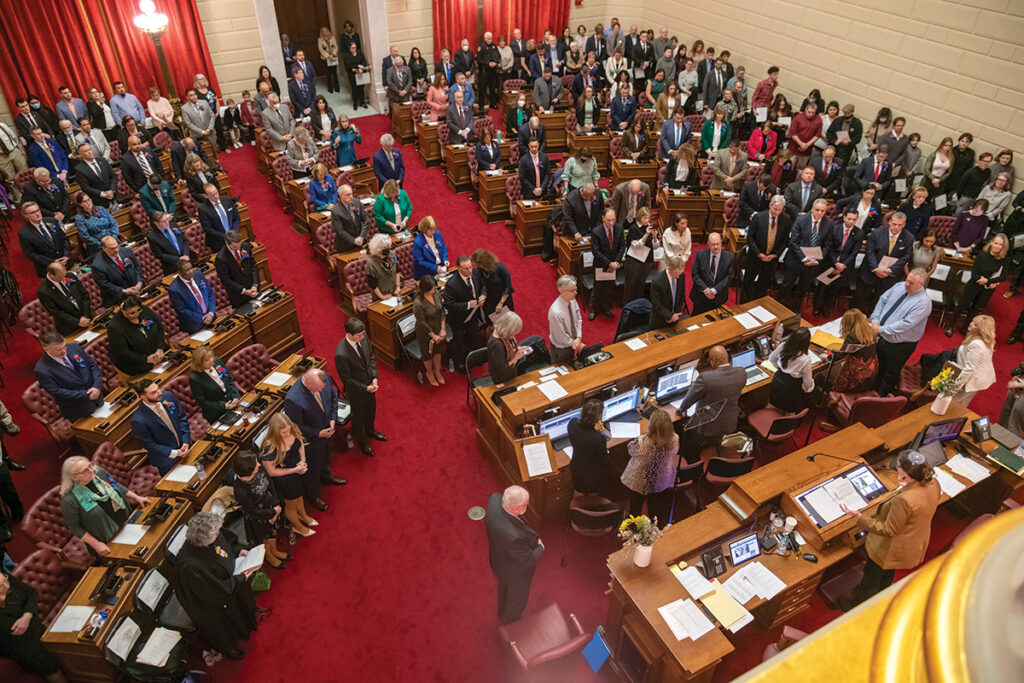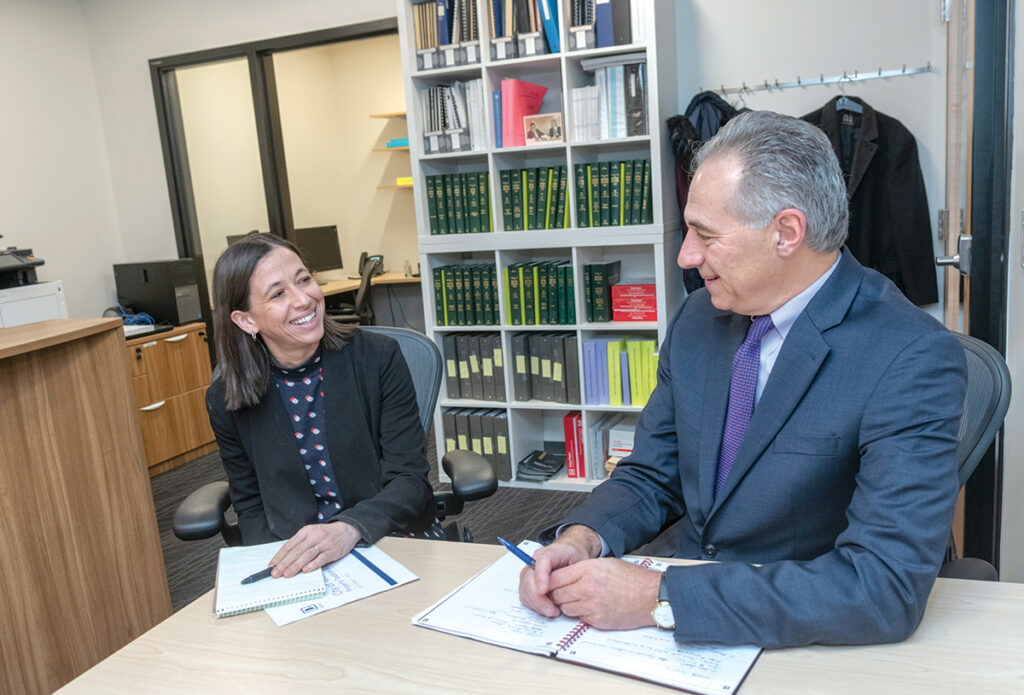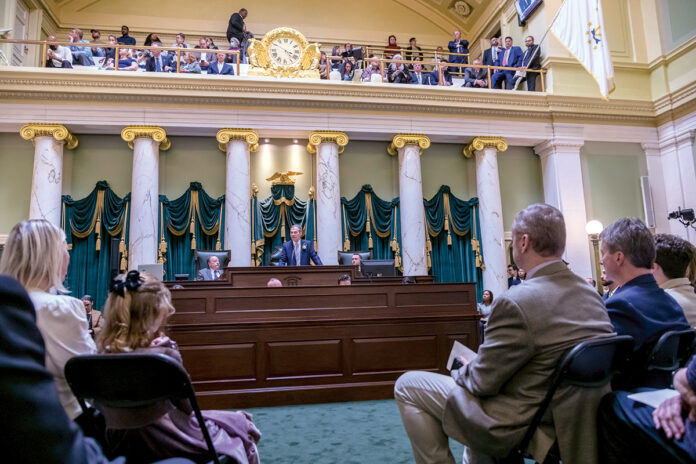No one would blame the General Assembly leadership if it breathed a little easier in the 2023 legislative session.
After all, the top Democratic leaders won reelection in the fall, the economic havoc touched off by the COVID-19 pandemic continues to fade and, for the second year in a row, state budget officials are projecting a massive surplus by the end of the fiscal year in June – estimated to be about $610 million right now.
But as state legislators took their seats on Jan. 3 to begin the new session, some challenges left over from the previous year awaited them, including housing instability and failing public schools. And with the prospect of rising energy costs and a potential recession creating economic uncertainty for 2023, state leaders are already mulling using some of the surplus for tax cuts. What type of cuts? There’s no consensus yet.
Already, the top legislators in both chambers have staked out priorities for the coming months, and it’s clear that divisions are forming.
House Speaker K. Joseph Shekarchi, beginning his third year in the legislature’s most powerful position, is backing the idea of creating a new quasi-public agency to cultivate a thriving life science and biotechnology hub similar to what already exists in Massachusetts.
Meanwhile, the focus of Senate President Dominick J. Ruggerio is squarely on changing the formula that the state uses to provide education aid to cities and towns, in hopes that modifications can help prop up struggling schools.
And while everyone agrees the scarcity of affordable housing in Rhode Island is a problem, not everyone agrees on how to solve it.
Shekarchi says to expect a host of new housing bills this session, ranging from easing local zoning restrictions so more homes can be built to purchasing defunct school buildings to be developed into places for people to live.
The Senate leadership, however, says lawmakers first should be scrutinizing how the state is using $250 million in American Rescue Plan Act money that already has been allotted for affordable housing. Ruggerio says he’s been displeased with the slow disbursement so far.
As usual, high on the General Assembly’s to-do list is approving a state budget for the 2024 fiscal year, which begins July 1. Gov. Daniel J. McKee is scheduled to submit his budget proposal later in January, a massive document that sets the administration’s priorities for the next 12 months.
Now that McKee has a fresh four-year term after an election victory in November, it’s unclear how the multibillion-dollar plan will be received by legislators.
Relations among McKee, Skekarchi and Ruggerio – all Democrats – have remained amicable. But how long will the good feelings last?
“There does seem to be a cooperative vibe in the air between the two branches of the [state] government,” said Wendy Schiller, Brown University political science professor and director of the Taubman Center for American Politics and Policy. “But state legislators and their leaders have to seek reelection sooner than McKee, so one should expect a few differences in opinion to emerge before the next reelection cycle.”
[caption id="attachment_426936" align="aligncenter" width="1024"]

STANDING ROOM ONLY: State representatives open the 2023 legislative session in the House chambers on Jan. 3. For the second year in a row, lawmakers begin their work as the state is projecting a massive surplus for the current fiscal year.
PBN PHOTO/
MICHAEL SALERNO[/caption]
The McKee administration has indicated that the budget proposal will include tax relief measures. He has previously said he’d like to lower the state’s 7% sales tax rate so it’s in line with the 6.25% rate in neighboring Massachusetts.
The administration also says the proposal will call for enhanced support for education, incentives for increasing housing construction and the replenishment of the state’s “rainy day” fund.
Shekarchi expects points of conflict among the leaders, even though the state’s financial picture looks bright right now.
“It’s not personal,” he said. “[It’s just that] their priorities may not match up with our priorities and vice versa.”
One point of agreement: Shekarchi and Ruggerio say 2024 is not the year for tax increases, a clear signal that they won’t be supporting the annual call by a union-backed coalition to raise the income tax rate for Rhode Island’s highest earners.
In fact, in a December interview with Providence Business News, Ruggerio and new Senate Majority Leader Ryan W. Pearson floated the idea of eliminating tangible property taxes, which are levied on businesses by municipalities for items such as equipment, furniture and fixtures.
Former Gov. Gina M. Raimondo made a similar proposal in 2020 – a plan that would have increased state aid to cities and towns to cover their lost tax revenue – but it was abandoned when the COVID-19 pandemic struck.
What matters are likely to draw legislative attention over the next six months? Here are a few likely candidates:
BUDGET SURPLUS
Buoying talk of tax reductions is the projected $610 million budget surplus, the second year in a row that the state is expected to end the year in the black after several years of structural deficits.
The latest estimates show revenues running ahead by 5%, which state fiscal advisers attribute to better-than-expected tax receipts, dollars remaining from last year’s budget surplus and significant job vacancies.
Still, Shekarchi is looking to temper expectations.
“That doesn’t mean we are going to have a surplus in May,” Shekarchi said in December. “And I’m sure there will be other issues that will pop up during the session. It’s all based on revenue. At any given moment we may run ahead with revenue, but we also may run behind.”
Pearson, too, notes that part of the surplus is due to more than 1,000 job openings in government. “As we fill those vacancies, you can expect a lot of that money is going to get eaten up,” he said.
Advocates working to shore up residents who are struggling financially have urged lawmakers to use some of the surplus for child care, health care and cash-assistance programs.
“We urge policymakers to deploy these once-in-a-generation funds toward systemic change, rather than dispersing the funds to a multitude of small projects, however valuable they may be,” said Weayonnoh Nelson-Davies, executive director of the Economic Progress Institute. “We need to think big.”
Brenda Clement, director of HousingWorksRI at Roger Williams University, says state leaders can learn from the temporary programs instituted during the pandemic, such as Rent Relief RI, which provided financial assistance to renters.
“These are programs that we started on a temporary basis and should continue because they work,” she said.
Michael DiBiase, CEO and president of the Rhode Island Public Expenditure Council, says lawmakers should be careful to avoid creating liabilities that will need to be funded with tax dollars in the future.
“That [surplus] money is one-time money. The budget is fairly tight from this year to next year,” he said. “[Programs] run on continuing revenues and most need continuing money, which becomes difficult if the economy weakens.”
If the surplus ends up being as big as projected, Shekarchi says he would rather return some money directly to the public.
“If we have some extra money, giving a strategic, targeted tax cut is not out of the question,” he said without naming potential cuts. “That is certainly on the table.”
[caption id="attachment_426938" align="aligncenter" width="1024"]

ON WATCH: Rhode Island Public Expenditure Council CEO and President Michael DiBiase, right, and Manager of Research Justine Oliva will be keeping a close eye on numerous fiscal issues during the 2023 legislative session.
PBN PHOTO/MICHAEL SALERNO[/caption]
ENERGY COSTS
The prospect of bigger energy bills is weighing heavy on the minds of many business and residential utility customers.
In October, customers saw a spike in electricity rates charged by Rhode Island Energy, the new name for the state’s primary gas and electric company. About half the respondents to a recent Providence Business New online poll said state lawmakers should provide relief from energy prices this session.
So far, the R.I. Public Utilities Commission has approved a six-month suspension of the $6 monthly charge for residential customers. And there was a $60, one-time credit on gas and electric charges for ratepayers, distributed on Nov. 1, using $32.5 million from the state’s settlement with PPL Corp., Rhode Island Energy’s parent company. Low-income ratepayers are getting additional rate relief through $3.8 million from the state’s Regional Greenhouse Gas Initiative, a move proposed by McKee.
The governor is also promising to introduce legislation to suspend the state’s 4% gross receipt tax on electricity bills through April, an action that Shekarchi and Ruggerio say they’re open to supporting.
At the same time, the two legislative leaders have said they “will be exploring other additional legislative options,” but they have yet to publicly identify other relief plans.
As for more progressive relief directly to ratepayers, DiBiase warns against using one-time money, whether from the budget surplus or federal dollars, to pay down customers’ utility bills.
How prices rise and fall in the short term is unknown. Energy costs will “continue to be an issue that everyone is feeling,” DiBiase said. “We haven’t had a complete conversation about these things. The cost issue has not been addressed.”
Meanwhile, assistance programs such as the Good Neighbor Energy Fund – subsidized by energy companies and private donations – have seen an increase in applications this winter.
The rising costs in housing and energy have been a “devastating combination,” said Cortney Nicolato, CEO and president of the United Way of Rhode Island Inc., which oversees the fund.
“And when you add the cold … it’s driving a rise in calls from households seeking energy assistance,” she said.
HOUSING DEVELOPMENT
In the previous legislative session, the General Assembly agreed to devote $250 million in ARPA money toward the construction of affordable housing, plus another $50 million for homeowner assistance.
What’s happened since then?
Advocates for the poor say the shortage of homes has not subsided, and rent and house prices remain far beyond the means of many people.
And that has Ruggerio openly criticizing the McKee administration’s handling of the $250 million allocation and questioning the performance of Josh Saal, who the governor appointed as the state’s first “housing czar” a year ago.
“I don’t think they did a good job getting the money out in a timely manner,” Ruggerio said.
For Clement, $250 million is only a down payment in rectifying the housing crisis.
“We are not investing enough state dollars. It’s simply not enough to keep up with existing demand, never mind growth,” Clement said. “We need to be producing X number of units each year just to keep up.”
To that end, Shekarchi says he’ll throw his support behind legislation that will make it easier to build homes, such as expanding the areas where multifamily and accessory dwellings can be constructed and allowing homes to be built in commercial and industrial zoning districts.
He also wants to investigate having the state purchase unused buildings such as schools for reuse as either temporary or permanent housing.
“It’s about production. The only way you solve the affordable housing crisis is to create more supply,” he said. “And the only way you build more supply is to create and convert [existing buildings into] housing.”
But Ruggerio and Pearson say allocating more money isn’t the answer, at least not until they see results from the $250 million set aside months ago.
“At this point [the questions are], ‘How are you doing? Are you making progress? And how can we help?’ ” Pearson said.
EDUCATION FUNDING
Leaders in the two chambers are clearly at odds over the state’s education funding formula.
Pearson, who has served as chairman of the Senate Finance Committee, characterized the formula as outdated and “arbitrary,” last amended in 2010.
“The needs of students have changed, and the costs of things have changed,” Pearson said.
Pearson says additional funding should be directed partly toward multilingual learners, a group whose numbers have continued to rise. And many students – approximately 10,000, according to Pearson – are left out of the current funding regime due to misclassification.
“We need to make sure [the formula] captures all of these students across the state,” he said.
Senate leaders plan to scrutinize the overall share the state pays to local municipalities and will look at instituting recurring increases, rather than a one-time allocation as was done during the pandemic, in which local districts were given between $40 million to $50 million.
Shekarchi argues that change isn’t needed right now.
“People say to change the formula. But what that means is to take money from one community and give extra money to someone else,” he said. “It’s a very dangerous thing to do.”
Instead, he would like to see better accounting for the federal money awarded to school districts.
“The local communities are flush with education money,” he said. “Before they come asking for new and more money, I want to see an accountability of what they had last year.”
DiBiase agrees the funding formula needs to be changed to divert more education aid to disadvantaged communities and to provide more financial support for charter schools.
“The reliance on property taxes is problematic because the communities that have the lowest wealth also [have the] most disadvantaged children,” he said.
Many parents are “voting with their feet” by moving to districts with better-performing schools and charter schools, he said.
“Public charter schools are some of the few bright spots for these kids,” DiBiase said.
LIFE SCIENCE HUB
Shekarchi has vowed to “lead the charge” for creating a new quasi-public agency to strengthen the state’s life sciences and biotech sector.
His support comes after a report from the Rhode Island Foundation in October outlined a plan to build a biotech sector to rival Massachusetts.
The plan: spend $50 million over two years, in part to forge state, private and academic partnerships that could give the sector a jump-start. At the same time, a quasi-public agency with a $1.5 million budget would use existing tax incentive programs offered by R.I. Commerce Corp. to woo biotech companies.
“It’s a unique opportunity,” Shekarchi said. “The timing is right because we have infrastructure money. If we can create a bioscience hub, we can create great therapies that will help people and hopefully create a good industry for private sector jobs.”
Carol Malysz, executive director of life sciences trade group RI Bio, says momentum is already building now that the state has broken ground on a new health lab and a wet lab is expected to be constructed nearby in the Jewelry District.
“Several companies have already expressed an interest in starting up, relocating or establishing a satellite office at these facilities,” she said of the Providence labs.
Shekarchi says he plans on reaching out to research and nonprofit institutions, as well as legislators, to gauge the support.
“The only way that process works is if you get buy-in and partnership not only from my other partners in government like the Senate and governor but with Brown University and other educational [institutions],” he said.
So far, Ruggerio hasn’t exactly embraced the idea.
He says he hasn’t talked with Shekarchi about the biotech initiative, but he is willing to listen. “If [Shekarchi] can bring in some companies, I think that would be helpful,” Ruggerio said.
What the Senate president would support, he says, is an expansion of workforce training and apprentice programs. “We have to get into the training business right now,” he said. “The economy is going to change. And those are the types of programs we need to move into the future.”
DiBiase remains on the fence while details are being formulated. But using tax dollars to “chase companies” to the state is rarely the best course of action, he said.
“We would be more supportive of investments to higher education for research or workforce training or for infrastructure such as lab space and would be less supportive of direct subsidies or tax incentives to individual biotech companies,” he said.
















For decades we’ve had a quasi-public agency to cultivate a thriving life science and biotechnology hub similar to what already exists in Massachusetts: The Slater Technology Fund. Why re-create the wheel? Just fund The Slater Technology Fund.